Sloanbaatar is a mammal genus that lived in Mongolia during the Upper Cretaceous. It lived at the same time as the dinosaurs. This animal was a member of the also extinct order Multituberculata within the suborder Cimolodonta and the family Sloanbaataridae.

The Turonian is, in the ICS' geologic timescale, the second age in the Late Cretaceous Epoch, or a stage in the Upper Cretaceous Series. It spans the time between 93.9 ± 0.8 Ma and 89.8 ± 1 Ma. The Turonian is preceded by the Cenomanian Stage and underlies the Coniacian Stage.
The Coniacian is an age or stage in the geologic timescale. It is a subdivision of the Late Cretaceous Epoch or Upper Cretaceous Series and spans the time between 89.8 ± 1 Ma and 86.3 ± 0.7 Ma. The Coniacian is preceded by the Turonian and followed by the Santonian.
The Santonian is an age in the geologic timescale or a chronostratigraphic stage. It is a subdivision of the Late Cretaceous Epoch or Upper Cretaceous Series. It spans the time between 86.3 ± 0.7 mya and 83.6 ± 0.7 mya. The Santonian is preceded by the Coniacian and is followed by the Campanian.
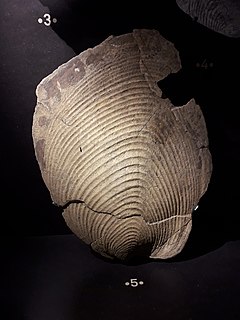
Inoceramus is an extinct genus of fossil marine pteriomorphian bivalves that superficially resembled the related winged pearly oysters of the extant genus Pteria. They lived from the Early Jurassic to latest Cretaceous.

Nipponites is an extinct genus of heteromorph ammonites. The shells of Nipponites form "ox-bow" bends, resulting in some of the most bizarre shapes seen among ammonites.
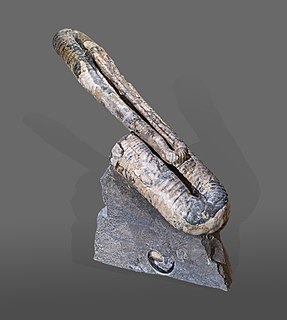
Polyptychoceras is an extinct genus of ammonites from the Late Cretaceous of Asia, Europe, and North and South America. It was first named by Hisakatsu Yabe in 1927.
The Milk River Formation is a sandstone-dominated stratigraphic unit of the Western Canada Sedimentary Basin in southern Alberta, Canada. It was deposited in near-shore to coastal environments during Late Cretaceous time. Based on uranium-lead dating, palynology and stratigraphic relationships, deposition occurred between ~84.1 and 83.6 Ma.
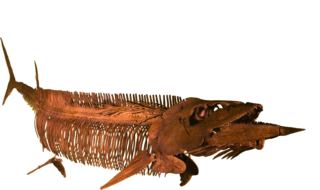
Saurodon is an extinct genus of ichthyodectiform fish from the Cretaceous.
Amphekepubis is a dubious genus of mosasaur from the Late Cretaceous of Mexico. Their remains correspond to the holotype specimen UM VP 509, a partial skeleton preserved in three dimensions, comprising the pelvic area, hind limb bones and nine caudal vertebrae, found in the east of Monterrey, in the state of Nuevo Leon, which come from marine sediments (claystones) apparently from the San Felipe Formation, which corresponds to the boundary between the ages of Coniacian and Santonian in the early Late Cretaceous. Amphekepubis is classified within the Mosasaurinae subfamily of mosasaurs.

The Santa Marta Formation is a geologic formation in Antarctica. It, along with the Hanson Formation and the Snow Hill Island Formation, are the only formations yet known on the continent where dinosaur fossils have been found. The formation outcrops on James Ross Island off the coast of the northern tip of the Antarctic Peninsula. In its entirety, the Santa Marta Formation is on average one kilometer thick.
The Eutaw Formation is a geological formation in North America, within the U.S. states of Alabama, Georgia, and Mississippi. The strata date from the late Coniacian to the early Santonian stage of the Late Cretaceous. It consists of the upper Tombigbee Sand Member and an unnamed lower member. Dinosaur, mosasaur, and pterosaur remains have been recovered from the Eutaw Formation.
Lomasuchus is an extinct genus of peirosaurid notosuchian known from the Late Cretaceous of Neuquén Province, western central Argentina. It contains a single species, Lomasuchus palpebrosus.
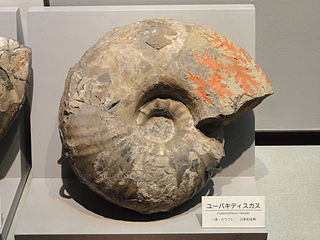
Eupachydisus is a large, coarse-ribbed Pachydiscid ammonite genus from the Upper Cretaceous, found in Coniacian to Campanian age strata in Europe, Madagascar, Japan, and British Columbia.

Plesioplatecarpus is an extinct genus of plioplatecarpine mosasaur known from the Late Cretaceous of the northern Gulf of Mexico and the Western Interior Basin of North America.
Gasparinisuchus is an extinct genus of peirosaurid notosuchian known from the Late Cretaceous of Neuquén and Mendoza Provinces, western central Argentina. It contains a single species, Gasparinisuchus peirosauroides.

Hauericeras is an ammonite genus from the Late Cretaceous that lived from the Coniacian to the late Maastrichtian, from about 90 to 66 mya. Fossils have been found in Europe, Russia, South Africa, Australia, India, Iraq, and in the United States.
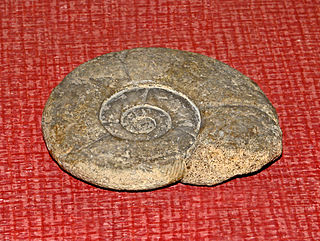
Puzosia is a genus of desmoceratid ammonites, and the type genus for the Puzosiinae, which lived during the middle part of the Cretaceous, from early Aptian to Maastrichtian. Sepkoski defines the range from Albian to Santonian. The generic name comes from the Serbian words "Puž" (snail) and "oce/ose" (axis), gaining its name from the shell's snail-like appearance.

The Conejo Formation (Spanish: Formación Conejo, K2C, Kscn) is a fossiliferous geological formation of the Altiplano Cundiboyacense, Eastern Ranges of the Colombian Andes. The uppermost unit of the Villeta Group, a sequence of shales and sandstones dates to the Late Cretaceous period; Turonian, Coniacian and Santonian epochs, and has a maximum thickness of 1,022 metres (3,353 ft).
Archichrysotus is an extinct genus of flies in the family Dolichopodidae. The generic name is a combination of the Greek prefix archi- and the generic name Chrysotus. The genus is known from Upper Cretaceous amber from the Taymyr Peninsula in Russia, New Jersey in the United States and Cedar Lake in Manitoba, Canada.










